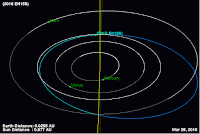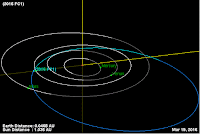Asteroid (455148) 1994 UG passed by the Earth at a distance of 6 644 000 km
(17.3 times the average distance between the Earth and the Moon, or 4.44% of the average distance between the Earth and the Sun), at about 1.45 pm GMT on Friday 25 March 2016. There was no danger of
the asteroid hitting us, though had it done so it would have presented a
considerable threat. (455148) 1994 UG has an estimated equivalent
diameter of 110-360 m (i.e. a spherical body with the same mass would be 110-360 m in diameter), and an object of this size
would pass through the atmosphere and directly impact the ground with a
force of about 10-2000 megatons (about 600-120 000 times the
explosive energy of
the Hiroshima bomb), causing devastation over a wide area and creating a
crater 1.5-5.5 km across, and resulting in global climatic problems that
could last for decades or even centuries.
The calculated orbit of (455148) 1994 UG. JPL Small Body Database.
(455148) 1994 UG was discovered on 28 October 1994 by the University of Arizona's Kitt Peak-Spacewatch Project at the Steward Observatory in
the Catalina Mountains north of Tucson. The designation 1994 UG implies
that it was the seventh asteroid (asteroid G) discovered in the second
half of October 1994 (period 1994 U), while
the designation 455148 implies that it was 455 148th asteroid ever
discovered (asteroids are not given this longer designation immediately
to avoid naming double or false sightings).
(455148) 1994 UG has a 503 day orbital period and an eccentric orbit tilted at an angle of 5.21° to the plane of the Solar System, that
takes it from 0.88 AU from the Sun (i.e. 88% of the average distance at
which the Earth orbits the Sun) to 1.60 AU from the Sun (i.e. 160% of
the average distance at which the Earth orbits the Sun,
outside the orbit of the planet Mars). It is therefore classed as an Apollo
Group Asteroid (an asteroid that is on average further from the Sun than
the Earth, but which does get closer). This means that close encounters between the
asteroid and Earth are extremely common, with the last having occurred
in August 2009 and the next predicted in September this year. As
an asteroid possibly larger than 150 m in diameter that occasionally
comes within 0.05 AU of the Earth, (455148) 1994 UG is also classified
as a Potentially Hazardous Asteroid. (455148) 1994 UG also has occasional close encounters with the planet Mars, with the next predicted for May 2026.
See also...
 Asteroid 2016 EN156 passes the Earth. Asteroid
2016 EN156 passed by the Earth at a distance of 601 800 km (1.57 times
the average distance between the Earth and the Moon, or 0.40% of
the average distance between the Earth and the Sun), slightly
before 6.25 am GMT on Saturday 19...
Asteroid 2016 EN156 passes the Earth. Asteroid
2016 EN156 passed by the Earth at a distance of 601 800 km (1.57 times
the average distance between the Earth and the Moon, or 0.40% of
the average distance between the Earth and the Sun), slightly
before 6.25 am GMT on Saturday 19... Asteroid 2016 EM156 passes the Earth. Asteroid
2016 EM156 passed by the Earth at a distance of 531 500 km (1.38 times
the average distance between the Earth and the Moon, or 0.56% of
the average distance between the Earth and the Sun), slightly
before 6.25 am GMT on Wednesday 16...
Asteroid 2016 EM156 passes the Earth. Asteroid
2016 EM156 passed by the Earth at a distance of 531 500 km (1.38 times
the average distance between the Earth and the Moon, or 0.56% of
the average distance between the Earth and the Sun), slightly
before 6.25 am GMT on Wednesday 16... Asteroid 2016 FC1 passes the Earth. Asteroid
2016 FC1 passed by the Earth at a distance of 167 800 km (0.44 times
the average distance between the Earth and the Moon, or 0.11% of
the average distance between the Earth and the Sun; 147 800 km above the
orbit at which the satellites supporting...
Asteroid 2016 FC1 passes the Earth. Asteroid
2016 FC1 passed by the Earth at a distance of 167 800 km (0.44 times
the average distance between the Earth and the Moon, or 0.11% of
the average distance between the Earth and the Sun; 147 800 km above the
orbit at which the satellites supporting...
Follow Sciency Thoughts on Facebook.

